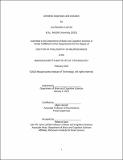Dendritic biophysics and evolution
Author(s)
Beaulieu-Laroche, Lou.
Download1252627400-MIT.pdf (8.982Mb)
Other Contributors
Massachusetts Institute of Technology. Department of Brain and Cognitive Sciences.
Advisor
Mark Harnett.
Terms of use
Metadata
Show full item recordAbstract
The biophysical features of neurons are the building blocks of computation in the brain. Dendrites are the physical site of the vast majority of synaptic connections and can expand the information processing capabilities of neurons. Due to their complex morphological attributes and various ion channels, dendrites shape how thousands of inputs are integrated into behaviorally-relevant outputs at the level of individual neurons. However, several long-standing issues limit our understanding of dendritic biophysics. In addition to distorted electrophysiological measurements, prior studies have largely been limited to ex vivo preparations from rodent animal models, providing little insight for computation in the awake human brain. In this thesis, we overcome these limitations to provide new insights on biophysics at the intersection of dendritic morphology and evolution. In chapter 1, we demonstrate that voltage-clamp analysis, which was employed to derive much of our understanding of synaptic transmission, is incompatible with most synapses because they reside on electrically-compartmentalized spines. We also develop new approaches to provide accurate measurements of synaptic strength. Then, in chapter 2, we directly correlate somatic and distal dendritic activity in the awake mouse visual cortex to show an unexpectedly high degree of coupling in vivo. In chapter 3, we perform dendritic recordings in large human neurons to reveal distinct integrative properties from commonly studied rat neurons. Finally, in chapter 4, we characterize neurons in 10 mammalian species to extract evolutionary rules governing neuronal biophysics and uncover human specializations. Together, these four thesis projects expand our understanding of the influence of dendritic geometry and evolution on neuronal biophysics.
Description
Thesis: Ph. D. in Neuroscience, Massachusetts Institute of Technology, Department of Brain and Cognitive Sciences, February, 2021 Cataloged from the official PDF version of thesis. "February 2021." Includes bibliographical references (pages 190-207).
Date issued
2021Department
Massachusetts Institute of Technology. Department of Brain and Cognitive SciencesPublisher
Massachusetts Institute of Technology
Keywords
Brain and Cognitive Sciences.